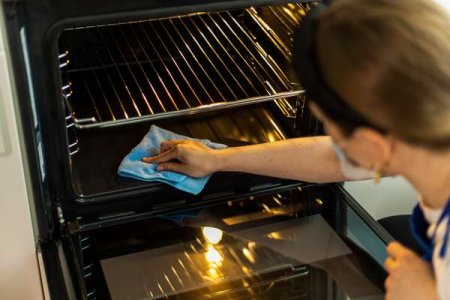Oven cleanliness: The best time and ways to turn up the heat on your cleaning routine!
- Replies 3
Cleaning an oven may not be on your list of favourite activities, and in the hustle and bustle of daily life, it's easy to overlook this essential kitchen appliance.
However, regular maintenance is crucial in keeping your kitchen spotless, and your appliance working at its best.
Whether you're preparing a family feast or cooking up a storm for the holidays, a clean oven ensures food tastes as it should, and prevents smoke and fire hazards.
Sally Vandermeer, who started her Naarm/Melbourne-based oven cleaning company in 2006, acknowledges that tackling the task of oven cleaning can seem 'slightly overwhelming'.
‘It's easy to close the door, hang your tea towel over the oven handle, and try and forget about it,’ she said.
According to Ms Vandermeer, the inside of the oven is frequently overlooked because, unlike the refrigerator, cleaning it can be time-consuming, sometimes requiring 2–3 hours.

Frequency and methods: The art of regular cleaning
The frequency of cleaning your oven depends heavily on how often and for what purpose you use it.
Sally Vandermeer and Fiona Mair, a Home Economist and Test Kitchen Coordinator at the Australian consumer advocacy group, CHOICE, concur that the magic ingredient is consistency.
‘Wipe it out after you finish eating, while it's still a bit warm,’ Ms Mair said.
She suggested utilising a microfibre cloth dampened with warm water, possibly added with dishwashing detergent.
‘I think people get a little bit daunted by cleaning their ovens because there's so many accessories in there,’ she added.
When it comes to deep cleaning, however, Ms Mair urged to thoroughly read the oven's instruction manual, and understand where all elements are located.
She recommended using low-effort, non-toxic substances such as vinegar and bicarb soda as a cleaning solution.
She also highlighted the virtue of steam cleaning with hot water and detergent or lemon juice in a stainless-steel bowl at the bottom of the oven, turning it up to 120 degrees celsius for up to an hour.
‘Let that steam soften all your residue, and then you just wipe it out,’ she said.
When cleaning the oven racks, Ms Mair advised soaking them in the bath or laundry sink with a tablespoon of laundry detergent and hot water.
She said, ‘once a year is fine to give it a real thorough clean’, which may involve removing and disassembling the door, and thoroughly wiping it down.
However, with more frequent cooking and grilling comes more cleaning times.
According to Ms Mair, ‘If you're using these toxic products do open your windows, get good ventilation because you don't want to be breathing that in,’ saying she only uses oven cleaner products as a ‘last resort’.
The benefits and realities of self-cleaning ovens
While Ms Vandermeer said that ‘some self-cleaning ovens work amazingly well,’ she recommended doing more research as some models still require a helping hand.
Ms Mair, on the other hand, suggested opting for a pyrolytic (or self-cleaning) for people who wish to upgrade and can afford one saying ‘it makes life so much easier’.
She advised running the self-cleaning function about three times a year for optimal hygiene and convenience.
‘It just turns everything to ash and you just wipe it out,’ she said, but reminded that while you can leave the accessories during cleaning for some models, others require their removal.
While people should be careful when consulting online for tips and tricks on how to clean our appliances, there are some that make sense.
From tips on how to speed up your oven cleaning process to tricks on how to make your dirty oven look brand new, there are trusted ways on cleaning our ovens on social media.

How do you tackle this hot topic in your household? Do you have a tried-and-true cleaning method for regular oven maintenance? Let us know in the comments below!
However, regular maintenance is crucial in keeping your kitchen spotless, and your appliance working at its best.
Whether you're preparing a family feast or cooking up a storm for the holidays, a clean oven ensures food tastes as it should, and prevents smoke and fire hazards.
Sally Vandermeer, who started her Naarm/Melbourne-based oven cleaning company in 2006, acknowledges that tackling the task of oven cleaning can seem 'slightly overwhelming'.
‘It's easy to close the door, hang your tea towel over the oven handle, and try and forget about it,’ she said.
According to Ms Vandermeer, the inside of the oven is frequently overlooked because, unlike the refrigerator, cleaning it can be time-consuming, sometimes requiring 2–3 hours.

Oven cleaning might be a daunting task for some, but is necessary to ensure food safety and taste. Credits: Shutterstock
Frequency and methods: The art of regular cleaning
The frequency of cleaning your oven depends heavily on how often and for what purpose you use it.
Sally Vandermeer and Fiona Mair, a Home Economist and Test Kitchen Coordinator at the Australian consumer advocacy group, CHOICE, concur that the magic ingredient is consistency.
‘Wipe it out after you finish eating, while it's still a bit warm,’ Ms Mair said.
She suggested utilising a microfibre cloth dampened with warm water, possibly added with dishwashing detergent.
‘I think people get a little bit daunted by cleaning their ovens because there's so many accessories in there,’ she added.
When it comes to deep cleaning, however, Ms Mair urged to thoroughly read the oven's instruction manual, and understand where all elements are located.
She recommended using low-effort, non-toxic substances such as vinegar and bicarb soda as a cleaning solution.
She also highlighted the virtue of steam cleaning with hot water and detergent or lemon juice in a stainless-steel bowl at the bottom of the oven, turning it up to 120 degrees celsius for up to an hour.
‘Let that steam soften all your residue, and then you just wipe it out,’ she said.
When cleaning the oven racks, Ms Mair advised soaking them in the bath or laundry sink with a tablespoon of laundry detergent and hot water.
She said, ‘once a year is fine to give it a real thorough clean’, which may involve removing and disassembling the door, and thoroughly wiping it down.
However, with more frequent cooking and grilling comes more cleaning times.
According to Ms Mair, ‘If you're using these toxic products do open your windows, get good ventilation because you don't want to be breathing that in,’ saying she only uses oven cleaner products as a ‘last resort’.
The benefits and realities of self-cleaning ovens
While Ms Vandermeer said that ‘some self-cleaning ovens work amazingly well,’ she recommended doing more research as some models still require a helping hand.
Ms Mair, on the other hand, suggested opting for a pyrolytic (or self-cleaning) for people who wish to upgrade and can afford one saying ‘it makes life so much easier’.
She advised running the self-cleaning function about three times a year for optimal hygiene and convenience.
‘It just turns everything to ash and you just wipe it out,’ she said, but reminded that while you can leave the accessories during cleaning for some models, others require their removal.
While people should be careful when consulting online for tips and tricks on how to clean our appliances, there are some that make sense.
From tips on how to speed up your oven cleaning process to tricks on how to make your dirty oven look brand new, there are trusted ways on cleaning our ovens on social media.
Key Takeaways
- Oven cleaning is typically seen as a daunting task, but can be managed by wiping down the oven interior after cooking, especially greasy foods.
- For a deeper clean, Fiona Mair, a Home Economist and Test Kitchen Coordinator at CHOICE, suggested using a combination of vinegar and bicarb soda, or a steam clean method with water and detergent or lemon juice.
- She recommended deep cleaning the oven at least once a year, but more frequently if it's used heavily for cooking and grilling.
- Self-cleaning ovens, particularly pyrolytic models, could greatly simplify the cleaning process, turning residue to ash that can be easily wiped away.
Last edited:







